Adler’s & Jung’s Insights for Artistically Creating Your Life: Part 2
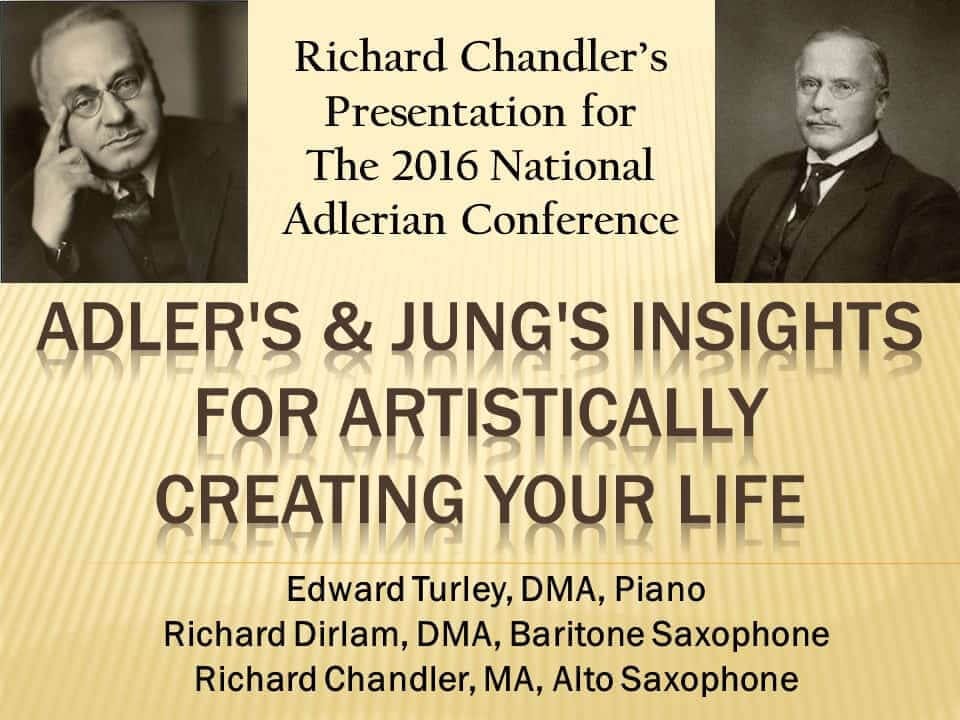
© 2024 Bonnett Chandler, MA, LPCC,
Richard Chandler, MA, LPC, Kelly Krueger, MA, LMFT
In May of 2016 I presented Adler's & Jung's Insights for Artistically Creating Your Life to the 64th annual conference of the North American Society of Adlerian
Psychology (NASAP) in Bloomington, MN.
Alfred Adler’s Insights for Artistically Creating Our Lives
Inferiority, Superiority And Assigned Meaning
Alfred Adler (1917) postulated that inferiorities themselves, including their manifestation within our bodies as organ inferiority, abnormal size, looks, or even traumas during our development, are less relevant to living fulfilling lives, than how we respond to our inferiorities (Adler, 1917). For Adler, our volition, our striving and our goal-orientation are paramount. His position sharply contrasted with that of Sigmund Freud, who posited that instinctual drives are the primary motivational determinants of human behavior. Adlerian authors Oberst and Stewart (2003) write:
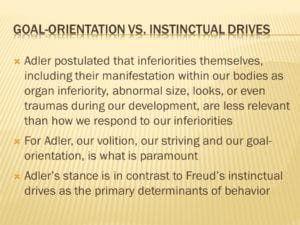
Adler’s & Jung’s Similar Insights
The Jungian Shadow Has Consonance With Adlerian Feelings Of Inferiority
Alfred Adler and Carl Jung were contemporaries, and for a time, both members of the Vienna Analytic Society (Hoffman, 1994). I found no evidence, however, that the concepts of inferiority, or the shadow aspects of being, were developed through collaboration, or any influence by one of these pioneering psychologists on the other. Both concepts appear to be independent constructs. Even so, our shadow and our inferiority do share some commonalities:
- Both our shadow, and inferiority, may reside to a large extent within the unconscious.
- They are often hidden, unwanted and exiled from conscious awareness.
- We often employ strategies to keep our shadow, and the inferior aspects of ourselves, hidden from others.
- Owning our shadow, and our inferiority, and publicly acknowledging their presence in our makeup, frees up the energy that is often used to hide their presence from others.
- Integrating inferiority, and our shadow, ultimately makes us stronger, more whole and more human to ourselves and to others.
Adlerian “Early Recollections” Relates To Jungian “Complexes Of Energies”
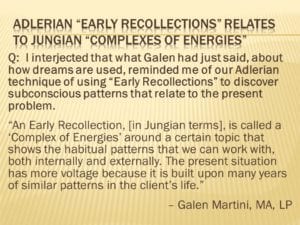
During one of my interviews with Galen Martini (2014), she had just expounded on a Jungian way to work with dreams. I interjected that her explanation reminded me of Alfred Adler’s technique of using “Early Recollections” to discover unconscious, or at least less conscious, patterns that relate to a presenting problem. Ms. Martini answered:
An Early Recollection, [in Jungian terms], is called a ‘Complex of Energies’ around a certain topic that shows the habitual patterns that we can work with, both internally and externally. The present situation has more voltage because it is built upon many years of similar patterns in the client’s life. (Martini, personal communication, September 5, 2014)
Life Itself May Be Understood As Being Embedded With Meaning
Throughout Carl Jung’s writings, we find evidence of how important “life-meaning” was to him. The following quotations illustrate this: “The least of things with a meaning is worth more in life than the greatest of things without it” (Jung, 2015). “Your vision will become clear only when you can look into your own heart” (Jung, 2015). “Who looks outside, dreams; who looks inside, awakes” (Jung, 2015). “The creation of something new is not accomplished by the intellect but by the play instinct acting from inner necessity. The creative mind plays with the objects it loves” (Jung, 2015). “As far as we can discern, the sole purpose of human existence is to kindle a light in the darkness of mere being” (Jung, 2015).
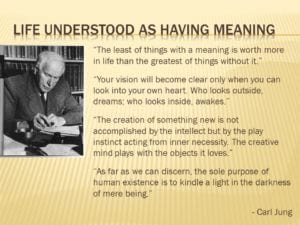
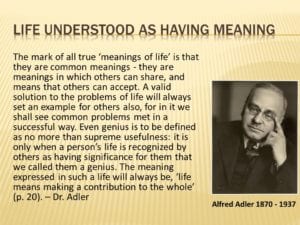
In Alfred Adler’s writings we also have a great many references to life-meaning. Here is one quotation that powerfully illustrates this:
The mark of all true ‘meanings of life’ is that they are common meanings – they are meanings in which others can share, and means that others can accept. A valid solution to the problems of life will always set an example for others also, for in it we shall see common problems met in a successful way. Even genius is to be defined as no more than supreme usefulness: it is only when a person’s life is recognized by others as having significance for them that we called them a genius. The meaning expressed in such a life will always be, ‘life means making a contribution to the whole’. (Adler, 1992, p. 20)
Jung’s Introverted Orientation Contrasts With Adler’s Extroverted Orientation
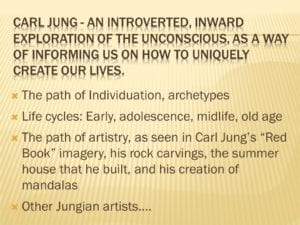
In general, Carl Jung preferred a more introverted, inward exploration of the unconscious, as a way of informing us on how to uniquely create our lives. We see evidence of this in many of his concepts including:
- The path of “Individuation”
- Jung’s exploration and extensive writings about archetypes
- Life cycles, including our infancy and early years, adolescence, midlife and old age
- The path of artistry, as seen in Carl Jung’s drawings, paintings, calligraphy, mandalas, rock carvings and the summer house that he designed and built
- The artistic creations of Jungian artists
In contrast to the inwardly focused approach of Carl Jung, Alfred Adler seemed to primarily connect to the world of others in an extroverted, outward way. His following concepts illustrate this:
- The life tasks of love, sex and marriage, work and career, and social relationships are about connecting to others.
- The movement from inferiority to superiority, as personal mastery in the service of contributing to the lives of others.
- Social interest and community feeling.
- His extensive work as a lecturer.
- Alfred Adler’s writings were predominantly assembled from his lectures rather than the more introverted approach of directly writing.
- Adler sang for others, even performing in public places.
- He had rickets yet chose to move his body extensively, in spite of the disease, which is an active, outward strategy rather than an inner, more meditative one.
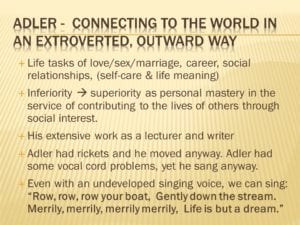
Author Edward Hoffman quoted Alfred Adler who described the difficulties he had as a young boy with rickets: “… for me movement of any sort was a strain…” Hoffman goes on to describe how the young Adler responded: “In the wide meadows that stretched behind the house, Alfred joined his many friends in vigorous games, and his rickets eventually dissipated” (E. Hoffman, p. 7).
Integrating Adler’s And Jung’s Insights For Artistically Creating Your Life
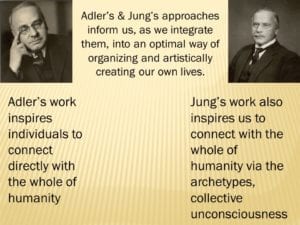
Adler’s & Jung’s approaches inform us as we integrate them into an optimal way of organizing and artistically creating our own lives.
Connecting With The Whole Of Humanity
Both Alfred Adler and Carl Jung emphasized the universality of our humanity and how we may connect more fully with our fellow humans. Dr. Adler inspires us to connect directly with the whole of humanity, through our work, our intimate relationships, all of our other social connections and even more universally by embracing social interest and community feeling as a way to be in the world.
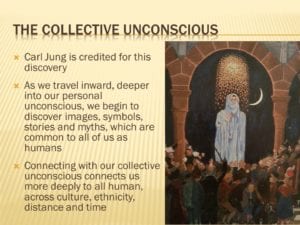
Dr. Jung also inspired us to connect with the whole of humanity via archetypes, the collective unconscious, the universality of symbols and by understanding and honoring cultures that might be quite different from our own. He did so in his own life through his connection with far Eastern, African and American Indian cultures employing travel, study and translation of their worldviews to expand the understanding of westerners in ways that deepened, corroborated and expanded our Western civilization’s psychological and philosophical models.
Adler And Jung Developed Methods For Mining Our Unconscious For Insights
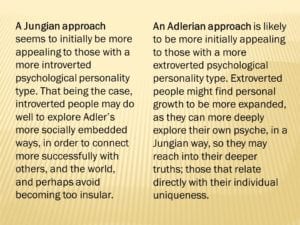
Carl Jung showed us ways to bring our unconscious shadow side into conscious awareness. By exploring our unconscious through dream-work, symbols, synchronous events and artistic pursuits, (including drawing with our non-dominant hand), we learn to pay attention to those dormant, unacknowledged or fragmented aspects of ourselves. Doing so helps us to become more whole by consciously deciding how we may incorporate those less conscious parts into the whole of our being.
Our inattention and ignorance of our shadow self, on the other hand, provides no protection against our shadow’s influence upon us; Eugene Beniek (2014) stated: “Our shadow will instead operate as a shadow government that at times hijack’s our lives” (Beniek, personal correspondence, August 2014).
Alfred Adler’s method for assessing peoples’ deeper and more fundamental life goals, known as the “Style of Life,” provides a way to bring those less-than-conscious ways of being into greater conscious awareness.
Through detailed questioning about upbringing we may learn of:
- Interactions and held beliefs by peoples’ mother, father, siblings and other significant family members.
- Psychological birth order, including the overall attitudes and beliefs that were individually embraced significance within the family.
- The gender roles that were modeled.
- Families’ held beliefs about the world itself.
All of these contribute to the overall way people choose to move through their lives. Absent a method like the style of life, peoples’ most fundamental life goals, their ways of moving through life and relating with others, might remain largely unconscious. Much like the shadow self, our style of life powerfully influences us. By bringing our style of life into conscious awareness, we are in a stronger position to choose how our past influences may inform the life we wish to live rather than dictate it.
Alfred Adler also had a way of working with dreams. Yet his most commonly utilized method for directly accessing our unconscious is the technique of asking for, recording and interpreting “Early Recollections” (ER’s). Like Jung, Alfred Adler’s dream techniques, style of life analysis and ER technique take us directly into our unconscious, so we might make the unknown in ourselves known.
This question was asked to Dr. Roger Ballou: “What Adlerian concepts relate to Jung’s work, for constructing our lives in an artistic way?” Dr. Ballou answered:
From what I know, which is a little bit, Jung and Adler had a belief that something larger unites us all; for Jung, the collective unconsciousness; for Adler, social interest. We hang in the balance because of each other. They both saw that in people, and their relationships, there is something larger.
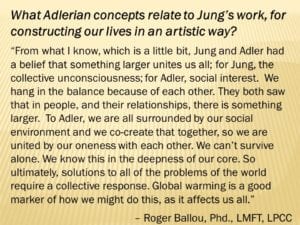
To Adler, we are all surrounded by our social environment and we co-create that together, so we are united by our oneness with each other. We can’t survive alone. We know this in the deepness of our core. So ultimately, solutions to all of the problems of the world require a collective response. Global warming is a good marker of how we might do this, as it affects us all. (Ballou, personal communication, September 9, 2014)
Our Psychological Personality Type Informs How We Might Artistically Proceed
An inner-directed Jungian approach might initially be more appealing to those with introverted psychological personality types. That being the case, introverted people may do well to explore Adler’s more socially embedded ways, in order to connect more broadly with others and reduce their risk of becoming insular. An Adlerian approach might initially be more appealing to those with greater extroversion in their psychological personality type. Extroverted people might find a greater depth of personal growth, however, as they can deeply explore their own psyche in a Jungian way by journeying deeply into their individual uniqueness.
Explore Jungian Concepts And Jungian-informed Artistic Techniques
Jungian concepts and Jungian-informed techniques are designed to uncover the deeper truths contained within our personal unconscious, and our collective unconscious, so that we might work with those truths productively, once we become consciously aware of them.
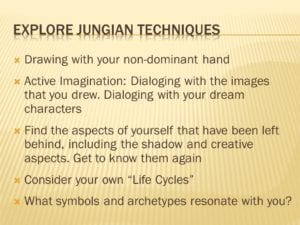
Many of the following techniques were gleaned primarily from artist, writer and Jungian analyst, Galen Martini:
- Write from the unconscious by clearing our minds, relaxing our bodies and journal, without. consciously directing the writing (Martini, personal communication, September 5, 2014)
- Assemble “Found Poems” by walking through a library or bookstore and jotting down the titles or parts of titles that seem to stand out for us. (Martini, personal communication, September 5, 2014)
- Draw with your non-dominant hand (Martini, personal communication, September 5, 2014)
Engage in “Active Imagination” through dialoging with the images that we have drawn. (Martini, personal communication, September 5, 2014) - Engage in “Active Imagination” through dialoging with the characters of our dreams. (Martini, 2011)
- Find and get to know those aspects of ourselves that have been left behind, including our shadow parts, as well as the creative aspects of our psyches. (Martini, personal communication, September 5, 2014)
- Reflect upon our “Life Cycles”
- Identify and explore those symbols and archetypes that resonate with us.
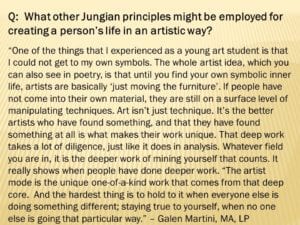
We might also benefit by entering into Jungian analysis with a qualified Jungian analyst so we can specifically explore our psyche in a more complete and in-depth way. In one of my interviews with Galen Martini, I posed this question: “What other Jungian principles might be employed for creating a person’s life in an artistic way?” She responded:
One of the things that I experienced as a young art student is that I could not get to my own symbols. The whole artist idea, which you can also see in poetry, is that until you find your own symbolic inner life, artists are basically ‘just moving the furniture’.
If people have not come into their own material, they are still on a surface level of manipulating techniques. Art isn’t just technique. It’s the better artists who have found something, and that they have found something at all is what makes their work unique. That deep work takes a lot of diligence, just like it does in analysis. Whatever field you are in, it is the deeper work of mining yourself that counts. It really shows when people have done deeper work.
The artist mode is the unique one-of-a-kind work that comes from that deep core. And the hardest thing is to hold to it when everyone else is doing something different; staying true to yourself, when no one else is going that particular way. (Martini, personal communication, September 5, 2014)
Explore Adlerian Techniques And Concepts
Alfred Adler’s writings that speak of movement powerfully inform how we might artistically create our lives. As we reflect upon where we have been, what we have done, and how our experiences have impacted us, we gain confidence for making decisions on our future direction, including those immediate actions that help us create new projects, connect with others in more significant ways and propel our lives forward.
For this writer, the path that leads to fruition is our quest for mastery by moving from inferiority to superiority. We intentionally move our lives forward on the horizontal axis of contributing to the welfare of others.
In addition to movement, useful Adlerian methods for artistically creating our lives include:
- Exploring our early recollections to gain present-time insights from our unconscious.
- Reflecting upon and strategically managing our life tasks, so we might more fully engage with others, thereby living with greater life balance.
- Embracing our inferiorities as an integral aspect of our humanness, so that we may free up the energy presently used to hide the parts of ourselves that we have deemed to be inferior.
- Moving horizontally towards community feeling by learning from, receiving from and giving to each other to deepen our bonds with those that we know and with all of humanity.
Alfred Adler’s optimistic and courageous response to vocal cord problems provides a model for how to best respond to life’s challenges in a creative and energized way. The inferiority of his voice did not deter him. Employing the same strategy of use and movement that he used to cure his rickets, Adler sang anyway, eventually developing both his singing voice and the strong lecturing voice.
Adler Graduate School of Minnesota Professor Herb Laube shared the story of visiting the historic Central Café in Vienna, along with Professor Marina Bluvshtein, where amateur musician Alfred Adler enjoyed singing music in both classical and popular idioms. (Laube, personal communication, June 6, 2014) For this writer, singing in both classical and popular styles exemplifies an egalitarian approach to music consistent with a high degree of social interest. In my interview with Roger Ballou (2014), he eloquently shared Adler’s way, saying:
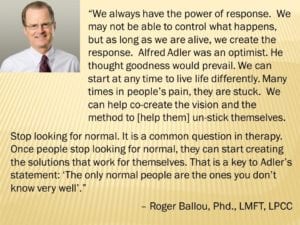
We always have the power of response. We may not be able to control what happens, but as long as we are alive, we create the response. Alfred Adler was an optimist. He thought goodness would prevail. We can start at any time to live life differently. Many times in people’s pain, they are stuck. We can help co-create the vision and the method to [help them] un-stick themselves.
Stop looking for normal. It is a common question in therapy. Once people stop looking for normal, they can start creating the solutions that work for them. That is a key to Adler’s statement: “The only normal people are the ones you don’t know very well. (Ballou, personal communication, September 9, 2014)
Generalized Protocol Summaries for Artistically Creating Our Lives
Utilize Adler’s Principle Of Teleological Movement
Alfred Adler postulated that much of our behavior can be ascribed to teleological movement towards our goals. But absent an introspective process, or a therapeutic process, which might include a style of life analysis for those involved with Adlerian psychotherapy, the goals themselves, and our movement towards those goals, often remain below conscious awareness. Intentionally employing teleological movement towards consciously formulated goals may be enhanced by:
- Directing our movement inward into the rich landscape of our unconscious, or even deeper, into our collective unconscious, to illuminate new insights and expand our existing understanding.
- After having an insight or inner discovery, retrieve it by moving outward from our unconscious back into our more usual conscious state, manifesting what we have discovered by translating it into form, via a medium of our choosing.
Choose Mediums Of Expression That Are Personally Optimal For Artistically Creating
- Alfred Adler’s primary medium of public lecturing, which may include storytelling, constitutes a powerful and expressive performance art that may profoundly captivate and influence watchers and listeners via sight, the depth and expression of hearing the speaker’s voice and the palpable group energy kinesthetically felt by most all who are present.
- Writing as fiction – which is a very sophisticated form of storytelling that typically incorporates the deeper and more poignant experiences that we have as humans – tends to connect writers and readers to the universality of our human experience.
- Nonfiction writing as a medium, (as both Carl Jung and Alfred Adler engaged in throughout their professional lives), has an advantage over public lecturing in communicating a greater breadth and depth of understanding, and offering the opportunity to reread a work, than is possible with public lectures.
- Movement arts, including dance, mime, acting and athletics, use our bodies themselves as a vehicle for communicating stories and human experiences within space, via rhythmic movement through time.
- The healing arts, including psychotherapy, make use of highly integrated sets of skills requiring a depth of knowledge, critical thinking and compassionate human connection with others for the purpose of relieving suffering and promoting wellness.
- Music composition – the creative manipulation of intervals and rhythm – allows composers to create a consistent world of sound, as each aspect of the composition aesthetically and synergistically relates to all of the other aspects of the work.
- Music performance, (engaged in by Alfred Adler through singing), compels musicians to honor the recipes that composers have created by freshly creating those compositions as unique, creative acts, which have a one-time existences within fixed segments of time, never to be created again in exactly the same way.
- The visual arts, including but not limited to drawing, painting, sculpture, pottery, weaving, glassblowing, architecture, artisan work and graphic design, exist within the world of space and may last from the time of their creation until their destruction.
- Science, technology, invention, entrepreneurial business, teaching and the full expression of human endeavors may be done creatively.
- The ultimate medium for everyone is our own lives, and how invent, reinvent and live them.
Embrace Existing Structure Or Create New Structure
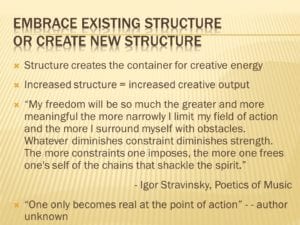
Structure creates the container for creative energy. Absent structure, creative people often experience the frustration of failing to produce actual creations. People commonly have the mistaken notion that limits, boundaries, and structure itself is the antithesis of being creative. But this is not so. Increased structure actually increases our creative output.
Become More Accepting Of Yourself, And Of Others
Artistically creating our lives can blossom through acceptance of our inferiorities and of our shadow self. Alternatively, having a perfectionistic stance typically leads to self-doubt and procrastination. Perfectionism is not the same as high standards; it instead consists of impossibly unrealistic standards, leading to despair. As we embrace our humanness, we become more humane. Accepting ourselves and embracing ourselves, as well as accepting and embracing our fellow humans, is integral to artistically creating the life that we want.
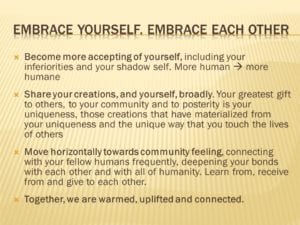
Share Your Creations, And Yourselves, Broadly
Our greatest gift to others, to our community, and to posterity, is our uniqueness. Sharing those creations that have materialized from our uniqueness, and the unique ways that we have touched the lives of others, serves to warm, uplift and connect us with our fellow humans and the whole of humanity.
Take Action
The one indispensable ingredient for artistically creating our lives is action. To truly benefit, we must do more than simply consider Adler’s and Jung’s insights for artistically creating our lives; we must act. This quotation, whose author is unknown to this writer, poignantly implores us to act: “One only becomes real at the point of action.”
Summary Ideas Of Alfred Adler And Carl Jung
For Carl Jung, the process of growth was primarily focused on journeying directionally inward, to deeper and deeper levels of the psyche, in exploration of our unconscious. In so doing, we are likely to perceive a great deal of our own reservoir of imagery, myth and psychic building-block materials from which we eventually construct a more artistically oriented life.
With an exclusive Jungian approach to artistically creating our lives, devoid of an Adlerian call to contribute and serve the whole of humankind, increased personal understanding may not necessarily make use of our increased inner psychological insights in ways that are practical and useful to our fellow humans.
For Adler, we also connect to our deeper and more inner aspects of our psyche, through the use of early recollections and exploration of our style of life. After connecting with our less conscious mental constructs, we may intentionally choose to analyze them through the lens of common sense and social interest, rather than through a private sense lens of viewing ourselves, our relationships and our place in the community.
This Adlerian approach places us in service to social interest as we artistically reinvent ourselves, fulfilling our life tasks and connecting us to the larger community of humans.
References
Adler, A. (1917). Study of organ inferiority and its psychical compensation. New York, NY: The Nervous and Mental Disease Publishing Company.
Adler, A. (1931). What life could mean to you. Rockport, MA: Oneworld Publications.
Ansbacher, H. L., & Ansbacher, R. R. (1956). The individual psychology of Alfred Adler: A systematic presentation in selections from his writings. New York, NY: Basic Books Inc.
Bottome, P. (1957) Alfred Adler: A portrait from life. New York, NY: The Vanguard Press
Chandler, R. J. (2013). Midlife reinvention to pre-death metamorphosis: Carl Jung’s travel-guide to the second half of life. Richfield, MN: Adler Graduate School.
Franken, A. S. (1991). Daily affirmations with Stuart Smalley. New York, NY: SNL.
Hoffman, E. (1994). The drive for self: Alfred Adler and the founding of individual psychology. Reading, MA: Addison-Wesley Publishing Company.
Jung, C. G. (1971). Psychological types. Princeton, NJ: Princeton University press.
Jung, C. G. (1964). Man and his symbols. London, England: Aldus Books Limited.
Jung, C. G. (1964). Online quotations retrieved from 'Segoe UI', Roboto, Oxygen, Ubuntu, Cantarell, 'Open Sans', 'Helvetica Neue', sans-serif;">http://www.brainyquote.com/quotes/authors/c/carl_jung.html
Jung, C. G. (2009). Introduction. In Shamadasani, S. (Ed.), The red book: Liber novus. (pp. 193-221). New York, NY: WW Norton & Company.
Martini, G. (2006). Finding your own life: The path to individuation. Saint Cloud, MN: IntegraLife Publishing.
Martini, G. (2011). Dream manual for therapists and other listeners. Saint Cloud, MN: North Star Press of Saint Cloud, Inc.
Millner, N. B. (2004) Applied Jungian psychology: Navigating the seasons of later life: A self-exploration guidebook for MBTI users. Greenville, SC: CAPT.
Mosak, H. H., Pietro, R. D. (2006). Early recollections: Interpretive method and application. New York, NY: Routledge, Taylor & Francis Group.
Myers, K. D., Myer, P. B. (2001, 2003). Myers-Briggs Type Indicator® Step II ™ (Form Q) Interpretive Report. Sunnyvale, CA: CPP, Inc.
Oberst, U.E., Stewart, A.E. (2003). Adlerian psychotherapy: An advanced approach to individual psychology. New York, NY: Brunner-Routledge.
Acknowledgements
I gratefully wish to thank, acknowledge and express my deep appreciation to my professors, our administration, staff, (with special thanks to Earl J. Heinrich), and fellow students of the Adler Graduate School
Galen Martini, MA, LP, Jungian Analyst and artist for your generous contribution of time, knowledge and original art. Your interviews opened the Jungian the world of artistry for me.
Roger Ballou, PhD, LMFT, LPCC for your interview and ongoing support, both for this project and through your supervision classes. I treasure your profound expression of Adlerian thought.
Marina Bluvshtein, PhD, LP, LMFT, my Master’s Project Chair, and Ev Haas, MA, my MP Reader, for your encouragement, for attending my November 8th, 2014 community presentation in Saint Cloud, MN, and for your insight and guidance throughout this Master’s Project.
Herb Laube, PhD, LMFT, for your contribution to my Master’s Project, your supervision mentorship and for your gift of connecting through stories.
Eugene Beniek, MA, LICSW, LMFT, for mentoring me through your role as my clinical supervisor. Your curiosity and compassion for clients continues to enthuse and inspire me.
Bonnett Chandler, my romantic mate, wife and practice partner. Taking this academic journey with you, hand-in-hand, has been delightful, satisfying, supportive, and in every way fantastic!
